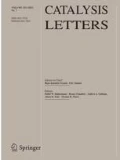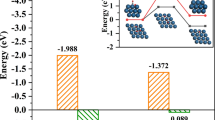Abstract
Doping Pt/ceria catalysts with alkali metals was found to lead to an important weakening of the formate C–H bond, as demonstrated by a shift to lower wavenumbers of the ν(CH) vibrational mode. However, with high alkalinity (∼2.5%Na or equimolar amounts of K, Rb, or Cs), a tradeoff was observed such that while the formate became more reactive, the stability of the carbonate species, which arises from the formate decomposition, was found to increase. This was observed by TPD-MS measurements of the adsorbed CO2 probe molecule. Increasing the amount of alkali to levels that were too high also led to lower catalyst BET surface area, the blocking of the Pt surface sites as observed in infrared measurements, and also a shift to higher temperature of the surface shell reduction step of ceria during TPR. When the alkalinity was too high, the CO conversion rate during water–gas shift decreased in comparison with the undoped Pt/ceria catalyst. However, at lower levels of alkali, the abovementioned inhibiting factors on the water–gas shift rate were alleviated such that the weakening of the formate C–H bond could be utilized to improve the overall turnover efficiency during the water–gas shift cycle. This was demonstrated at 0.5%Na (or equimolar equivalent levels of K) doping levels. Not only was the formate turnover rate found to increase significantly during both transient and steady state DRIFTS tests, but this effect was accompanied by a notable increase in the CO conversion rate during low temperature water–gas shift.









Similar content being viewed by others
References
Sato S, White JM (1980) J Am Chem Soc 102:7206
Wagner FT, Somorjai GA (1980) J Am Chem Soc 102:5494
Sato S, White JM (1981) J Catal 69:128
Vedage GA, Pitchai R, Herman RG, Klier K (1984) Proc. 8th Internat. Congress on Catal., Berlin, Germany, p 47
Klier K (1992) Catal Today 15:361
Campbell CT, Koel BE, Daube KA (1987) J Vac Sci Technol A 5:810
Campbell JM, Nakamura J, Campbell CT (1992) J Catal 136:24
Basinska A, Domka F (1993) Catal Lett 17:327
Basinska A, Domka F (1997) Catal Lett 43:59
Jozwiak WK, Basinska A, Goralski J, Maniecki TP, Kincle D, Domka F (2000) Stud Surf Sci Catal 130:3819
Luukkanen S, Homanen P, Haukka M, Pakkanen TA, Deronzier A, Chardon-Noblat S, Zsoldos D, Ziessel R (1999) Appl Catal 185:157
Luukkanen S, Haukka M, Kallinen M, Pakkanen TA (2000) Catal Lett 70:123
Brooks CJ, Hagemeyer A, Yaccato K, Carhart R, Herrmann M (2005) 19th North Am. Catal. Soc. Meeting, May 22–27, Philadelphia, Pennsylvania, USA
Yaccato K, Carhart R, Hagemeyer AG, Herrmann M, Lesik A, Strasser P, Turner H, Volpe1 AF, Weinberg H, Brooks CJ (2006) AIChE Spring National Meeting April 23–27, 2006, Orlando, FL
Pigos JM, Brooks CJ, Jacobs G, Davis BH (2006) Prepr Am Chem Soc Div Pet Chem
Pigos JM, Brooks CJ, Jacobs G, Davis BH (2006) Evidence of enhanced LTS water–gas shift rate with Sodium promoted Pt-ZrO2-based catalyst discovered by combinatorial methods, AIChE Annual Meeting abstract
Shido T, Iwasawa Y (1993) J Catal 141:71
Pigos JM, Brooks CJ, Jacobs G, Davis BH (2007) Appl Catal A: General 319:47
Pigos JM, Brooks CJ, Jacobs G, Davis BH Appl Catal A: General, (in press)
Li Y, Fu Q, Flytzani-Stephanopoulos M (2000) Appl Catal B 27:179
Lavalley JC (1996) Catal Today 27:377
Yao HC, Yu Yao YF (1984) J Catal 86:254
Laachir A, Perrichon V, Badri A, Lamotte J, Catherine E, Lavalley JC, El Fallah J, Hilaire L, Le Normand F, Quemere E, Sauvion GN, Touret O (1991) J Chem Soc Faraday Trans 87:1601
Jacobs G, Graham UM, Chenu E, Patterson PM, Dozier A, Davis BH (2005) J Catal 229:499
Jacobs G, Das TK, Zhang Y, Li J, Racoillet G, Davis BH (2002) Appl Catal A: General 233:263
Binet C, Daturi M, Lavalley JC (1999) Catal Today 50:207
Shido T, Iwasawa Y (1992) J Catal 136:493
Li C, Sakata Y, Arai T, Domen K, Maruya KI, Onishi T (1989) J Chem Soc Faraday Trans I 85:1451
Tabakova T, Boccuzzi F, Manzoli M, Idakiev V, Andreeva D (2003) Appl Catal A: General 252:385
Fukunaga T, Ponec V (1997) Appl Catal A: General 154:207
Larsen G, Haller GL (1989) Catal Lett 3:103
Holmgren A, Anderson B, Duprez D (1999) Appl Catal B 22:215
Mojet BL, Miller JT, Koningsberger DC (1999) J Phys Chem B 103:2724
Acknowledgment
The work was sponsored by the Commonwealth of Kentucky.
Author information
Authors and Affiliations
Corresponding author
Rights and permissions
About this article
Cite this article
Evin, H.N., Jacobs, G., Ruiz-Martinez, J. et al. Low Temperature Water–Gas Shift: Alkali Doping to Facilitate Formate C–H Bond Cleaving over Pt/Ceria Catalysts—An Optimization Problem. Catal Lett 120, 166–178 (2008). https://doi.org/10.1007/s10562-007-9297-0
Received:
Revised:
Accepted:
Published:
Issue Date:
DOI: https://doi.org/10.1007/s10562-007-9297-0




